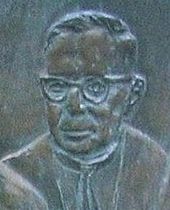Franz Wosnitza
Franz Wosnitza (born October 3, 1902 in Czarnowanz , † November 4, 1979 in Cologne ) was a German Roman Catholic priest and 1942–1945 vicar general and de facto administrator of the diocese of Katowice . The native of Upper Silesia campaigned for balance and reconciliation between Germans and Poles regardless of the political situation .
Life
Wosnitza, son of a bricklayer foreman , came with the family to Königshütte in 1906 , which became Polish in 1921 as a result of the First World War . In 1922 he passed the Abitur there. He then studied theology in Breslau , at the same time perfected his knowledge of Polish and decided after the establishment of the diocese of Katowice to belong to it. He finished his studies in Cracow and was ordained a priest on June 20, 1926 in Katowice by Bishop August Hlond .
As a chaplain at the Katowice interim cathedral St. Peter and Paul , he took care of the German-speaking parishioners with great commitment. 1933 Bishop appointed him Stanisław Adamski for Diocesan Praeses for the German-speaking youth and the editor of the church newspaper The Sonntagsbote . In agreement with the diocese leadership, he coordinated German-speaking religious life through pilgrimages and educational events.
After the German invasion of Poland in September 1939, under the pressure of the new balance of power, in January 1940, Bishop Adamski appointed Franz Strzyz, who belongs to the German ethnic group, as vicar general and Franz Wosnitza as ordinarian councilor in October 1940 . In February 1941, Bishop Adamski was expelled from the occupation regime. Until the end of the war, Wosnitza headed the diocese as vicar general, initially under Strzyz, then since 1942, authorized by Adamski.
Under the most difficult conditions, the bilingual Wosnitza tried to do justice to his pastoral mandate, to resist the separation of ethnic groups and the Germanization and to stand up for the numerous Polish priests who were imprisoned in concentration camps . He found lasting recognition among German and Polish Silesians.
When Bishop Adamski returned after the end of the war, he replaced Wosnitza as vicar general, but kept him in the diocese leadership and commissioned him to rebuild the destroyed churches. Nevertheless, Franz Wosnitza was expelled to Germany in July 1946.
He initially worked as a pastor in Werdohl and Bochum . From 1949 to 1972 he was head of the Catholic Settlement Service in Cologne , whose task in the first decades was to create living space for displaced and bombed-out people.
Franz Wosnitza remained incardinated in Katowice and devoted himself to the end of his life, a. a. through the publication of a circular and through material aid, the cohesion and support of the Katowice diocesans in Germany and Poland. After his death on November 4, 1979, his memorial was celebrated both in Cologne and in Katowice with the participation of high representatives from both dioceses and numerous believers.
Honors
In 1972 Franz Wosnitza received the Great Cross of Merit of the Federal Republic of Germany. In the same year Pope Paul VI appointed him . to the Apostolic Protonotary .
Literature (selection)
- Maik Schmerbauch: Prelate Franz Wosnitza (1902–1979). Former Vicar General of Katowice (Works on the Silesian Church History 21). Munster 2010.
- Franz Wosnitza: Beyond the border , in: Life in Silesia. Memories from five decades. Edited by Herbert Hupka . Munich 1962, pp. 199-216
- Karl Heda: Franz Wosnitza (1902–1979) , in: Silesian Church in Life Pictures. Edited by Johannes Gröger, Joachim Köhler and Werner Marschall . Sigmaringen 1992, pp. 223-227
- Jerzy Myszor : Wosnica (Wosnitza) Franciszek (Franz) , in: Słownik biograficzny katolickiego duchowieństwa śląskiego XIX i XX wieku. Katowice 1996, pp. 469-471
Web links
- Wosnitza, Franz . In: East German Biography (Kulturportal West-Ost)
Individual evidence
- ↑ Announcement of awards of the Order of Merit of the Federal Republic of Germany. In: Federal Gazette . Vol. 25, No. 43, March 9, 1973.
| personal data | |
|---|---|
| SURNAME | Wosnitza, Franz |
| BRIEF DESCRIPTION | German Catholic clergyman, vicar general in Katowice |
| DATE OF BIRTH | October 3, 1902 |
| PLACE OF BIRTH | Czarnowanz |
| DATE OF DEATH | 4th November 1979 |
| Place of death | Cologne |
